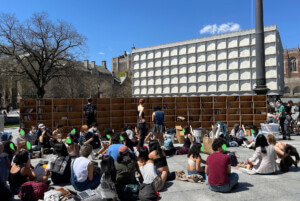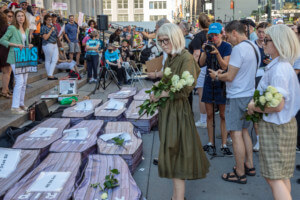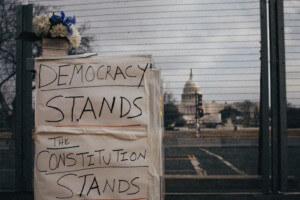To celebrate our 15th anniversary, we looked back through the archives for our favorite moments since we started. We found stories that aged well (and some that didn’t), as well as a wide range of interviews, editorials, and other articles that we feel contributed to the broader conversation. We also took a closer look at the most memorable tributes to those we lost, and heard from editors past and present about their time here.
Here, we rounded up some of the most significant political shifts and statements that have run through our pages.
2003
Protest: Michael Sorkin on Ground Zero
“Stop the demeaning arrogance of business-as-usual and the construction of an architectural zoo on this hallowed ground.”
2005
“Tens of thousands of blue-collar white, Asian, and Latino residents of afflicted Gulf communities also face de facto expulsion from the region, but only the removal of African-Americans is actually being advocated as policy.”
2007
“As Mayor Cory A. Booker swept into office in 2006 on a platform of radical reform, he vowed to make Newark a ‘national standard for urban transformation.’”
2008
Little has changed since deadly accident at Trump Soho
“Despite complaints for months of an errant crane and other unsafe work conditions at the Trump Soho construction site; despite biweekly inspections by the city’s Department of Buildings; despite a previous tragedy on another of the general contractor’s worksites; despite all these warnings and precautions, it was not until the death of Yuriy Vanchytskyy, a construction worker from Greenpoint who fell 40 stories when a portion of the 42nd floor collapsed on January 12, that Bovis Lend Lease’s crane fell silent on the 46-story project.”
2010
“After 21 years as mayor, Richard M. Daley has left an indelible mark on Chicago’s built environment. The Architect’s Newspaper asked 11 Chicago architects to reflect on Daley’s impact on the city’s architecture, planning, and landscape, and to ponder the challenges facing the next mayor.”
2013
“AN Editor-in-Chief William Menking convened a diverse group of thinkers to discuss the recent book Beyond Zuccotti Park, Freedom of Assembly and the Occupation of Public Spaces, an anthology on the Occupy Movement and the role of urban design and public space in contemporary democracy. Activist and curator Aaron Levy, planner Laura Wolf Powers, and architect Srdjan Jovanovic Weiss participated.”
2016

How institutionalized racism and housing policy segregated our cities
“In Baltimore in 1910, a black Yale law school graduate purchased a home in a previously all-white neighborhood. The Baltimore city government reacted by adopting a residential segregation ordinance, restricting African Americans to designated blocks. Explaining the policy, Baltimore’s mayor proclaimed, ‘Blacks should be quarantined in isolated slums in order to reduce the incidence of civil disturbance, to prevent the spread of communicable disease into the nearby White neighborhoods, and to protect property values among the White majority.'”
AIA pledges to work with Donald Trump, membership recoils
“When an institution assumes control of all its members’ opinions without inviting debate, when it commits itself to as-yet-unspecified agendas, and ignores the human and environmental costs of its pledged actions, that institution is not neutral – it is complicit with the forces which seek to limit public life. We must remind ourselves that totalitarian regimes look to architects to build their image of strength and legacy without questioning the costs, and that to collaborate is to normalize those systems.”
2017

Milwaukee 50 years later, where the fight for fair housing continues
“The lines dividing African Americans from whites have shifted, but are still staggeringly apparent. While the larger conversation about housing today is focused on affordability and sustainability, it is worth remembering that the simple act of wanting to live where you want is a battle that has been going on for decades.”
2018
How the “Shitty Architecture Men” list can address abuse in architecture
“Thanks to the #MeToo movement and the Shitty Architecture Men list, many survivors of harassment and assault in the architecture industry will, for the first time, experience the sense that they are believed and validated. They can recognize that the abuse of power follows recognizable patterns, and is neither unique nor deserved.”
EPA is now allowing asbestos back into manufacturing
“As The Post covered, Trump has long been vocal about his skepticism about the harmful effects of asbestos, claiming in his 1997 book, The Art of the Comeback, that anti-asbestos efforts were ‘led by the mob.'”
Check out a selection of our favorite bits of gossip here, our best interviews here, and a fuller timeline of our articles here.











